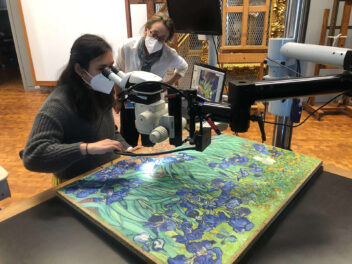
Early autumn along the stream
It’s hard to imagine the Getty Center without its bold yet inviting greenery, paths, and blooms—a living work of art. The Central Garden was designed by Robert Irwin, an artist who had gained prominence for his Abstract Expressionist paintings and public installations. In 1997 he brought his eye for light, space, and scale in his landscape design to the Getty Center.
A few years after the Getty Center opened, writer and critic Lawrence Weschler accompanied Irwin on a series of walks around the Central Garden. During these walks, Irwin talked about the critical choices he made to create this unique, ever-changing space. In 2002 these conversations were published in Robert Irwin Getty Garden, a book that reveals the artistic intent behind the garden’s design.
A revised edition of the book was published earlier this year and is available now. In this excerpt, Irwin describes how he sought to build intimacy within the grand scale of the garden, encouraging visitors to find beauty and joy in even the smallest details.

Aerial view of the bowl garden
Robert Irwin One of the elements of the garden is this process of enticing and pulling you down. Your first view of it, of course, from up here or one of the other vista points, is as this really strong graphic element, which is one of the reasons why I left the green around the side, so that you’d get this really clear configuration in the middle. That’s what supplies much of the scale of the garden, as up against the grand scale of the surrounding architecture. But what you see is, hopefully, interesting enough that you are being enticed to come down to the path over there to the side. And then the path itself draws you down to the plaza, and the plaza then lets you look down on the bowl, and then, hopefully, you have the desire to want to descend into the bowl. So the whole thing is a series of descents, becoming, in a sense, more intimate as you go along.
I think intimacy was really one of the key elements that was missing from the whole Getty experience, especially with regard to the architecture. Which was not necessarily the job of the architecture. But it was one of the things the architecture didn’t really take into consideration—and that even went for the people who work here: a place where you could go that was essentially quiet and sort of down-in and surrounded and…
Lawrence Weschler Nested.
Irwin Yeah, nested. And the garden really does go through a process of nesting itself as it goes down. It starts with the big scale up here, the overall bang, and then hopefully takes you by degrees—in terms of your willingness to participate—down to a more and more intimate level.
It all reminds me of my early days as an Abstract Expressionist, when I was first exposed to Raku ware, which was very interesting for me because Abstract Expressionism, as you know, was so committed to this idea of large scale. And for good reason: when you took the figure out, scale became an element in and of itself, a thing. You know, a real thing. So I was doing huge paintings, but one of my first introductions to Raku was this guy who would—
Weschler What is Raku, by the way?
Irwin Raku is a Japanese tea-ceremony bowl that has a kind of almost… I mean, it’s become a national treasure in Japan. With very much of a kind of a Zen overtone to it. And the thing about it was that this person who had collected these bowls, if your karma was right, he would let you see a tea bowl. And the way he would do it is you would have dinner with him and at the end of the dinner, he would set on the table this box with a beautiful little tie on it—very Japanese—and you untied it, you opened up the box, he let you do that. And then inside of it was a cloth sack. You took the sack out, and it had a drawstring, and you opened up the drawstring and you reached inside and took out the bowl. By that time, the bowl had you at a level where the most incidental detail—maybe even just a thumb mark—registered as a powerful statement.
And this whole idea of how you bring somebody down to a level of awareness where they can deal with intimacy, they can deal with the most subtle kind of nuance—that kind of thing is normally lost in the bigger scale. So the idea here is that even though you start out with this kind of grand scale, hopefully, by the end, you’re able to really look—and I’ll show you when we get down there—to really gaze in wonder upon a single flower: this petal, that stalk. One of the reasons for raising the platforms of the flowers in some areas down there is so that you don’t even have to bend down: you can really just look at a flower up close.
This excerpt is from the publication Robert Irwin Getty Garden by Lawrence Weschler © 2002, 2020 J. Paul Getty Trust.




During long days of Summer, I often enjoy a Getty Garden experience on Saturdays when my shift ended a 6pm before heading home. Visitors often are spotted with very specialized camera equipment to capture by macro-photography the beauty of leaf or flower petal with a visiting insect or pollinator. On occasion, when I know I want to explore the Central Garden on a Saturday after work and before Sunset, I bring my 6.5 x 21Pentax Papilio binoculars, “papilio” is Latin for butterfly. These wonderful optics have an extremely close focus to 1.5 feet (about 18″) at 6.5 power. You can actually see with clarity the hairs on a bees legs and other minute detail. Fantastic for flowers. Jeff Wood, Getty Museum Store Associate